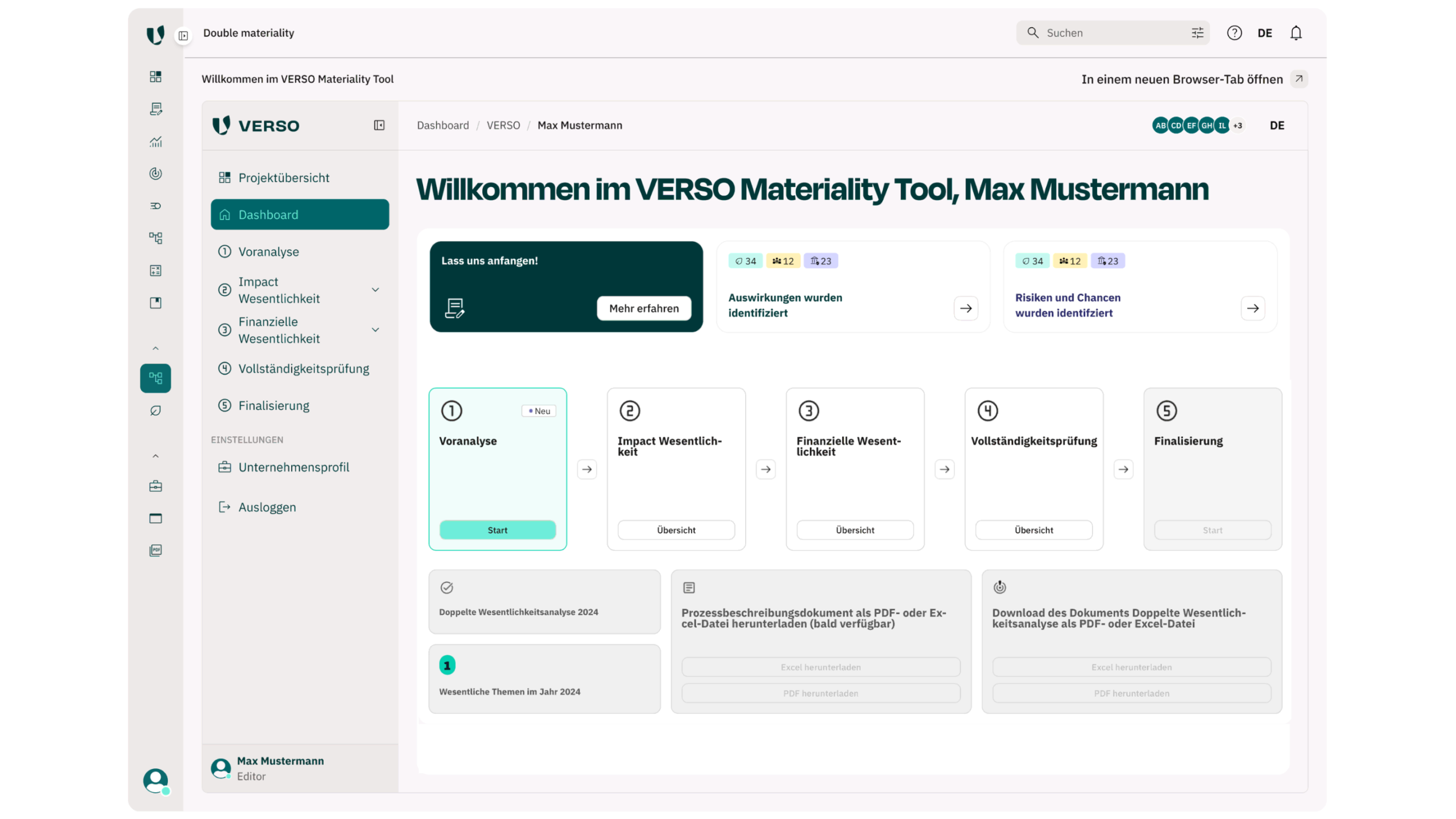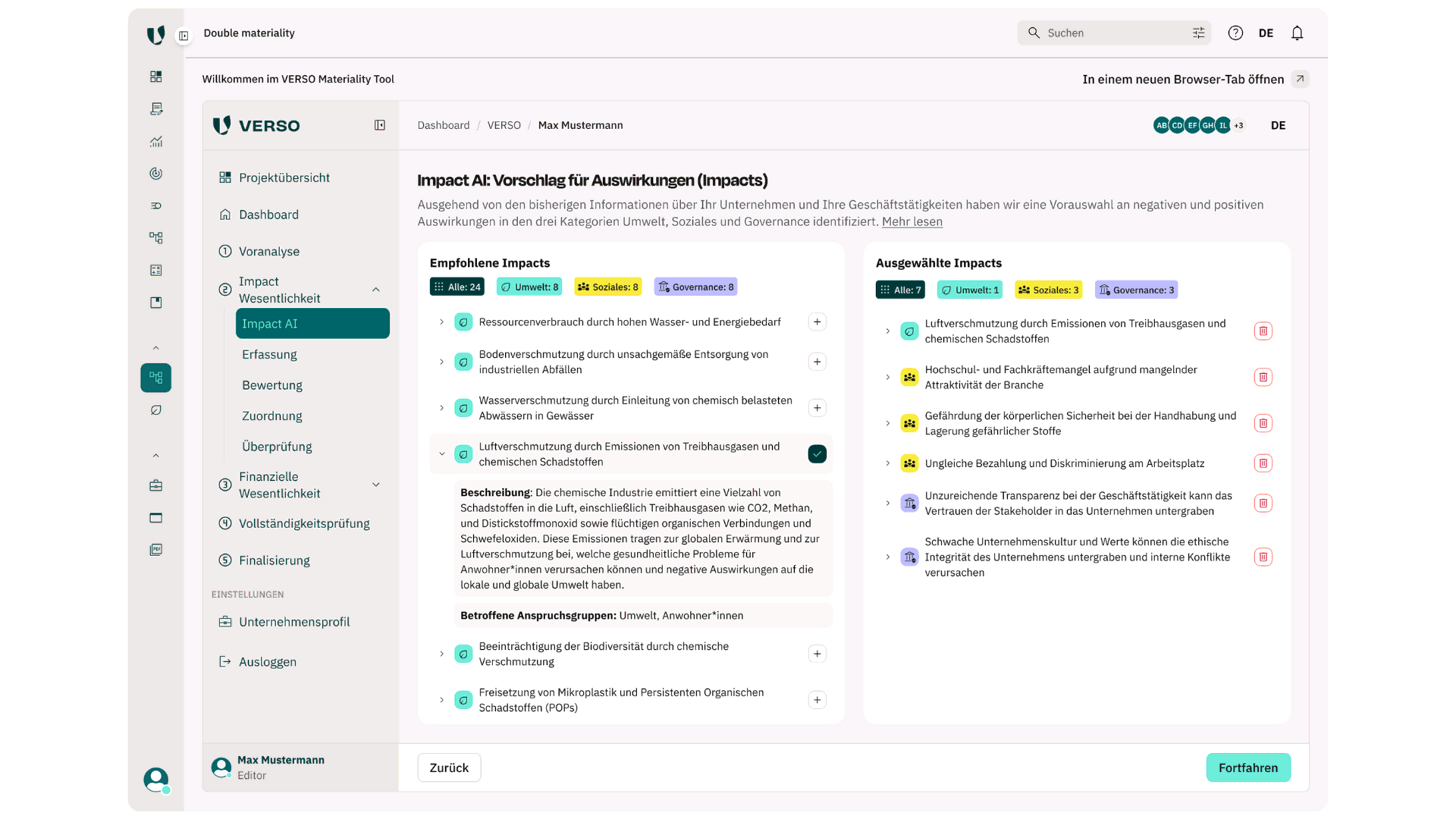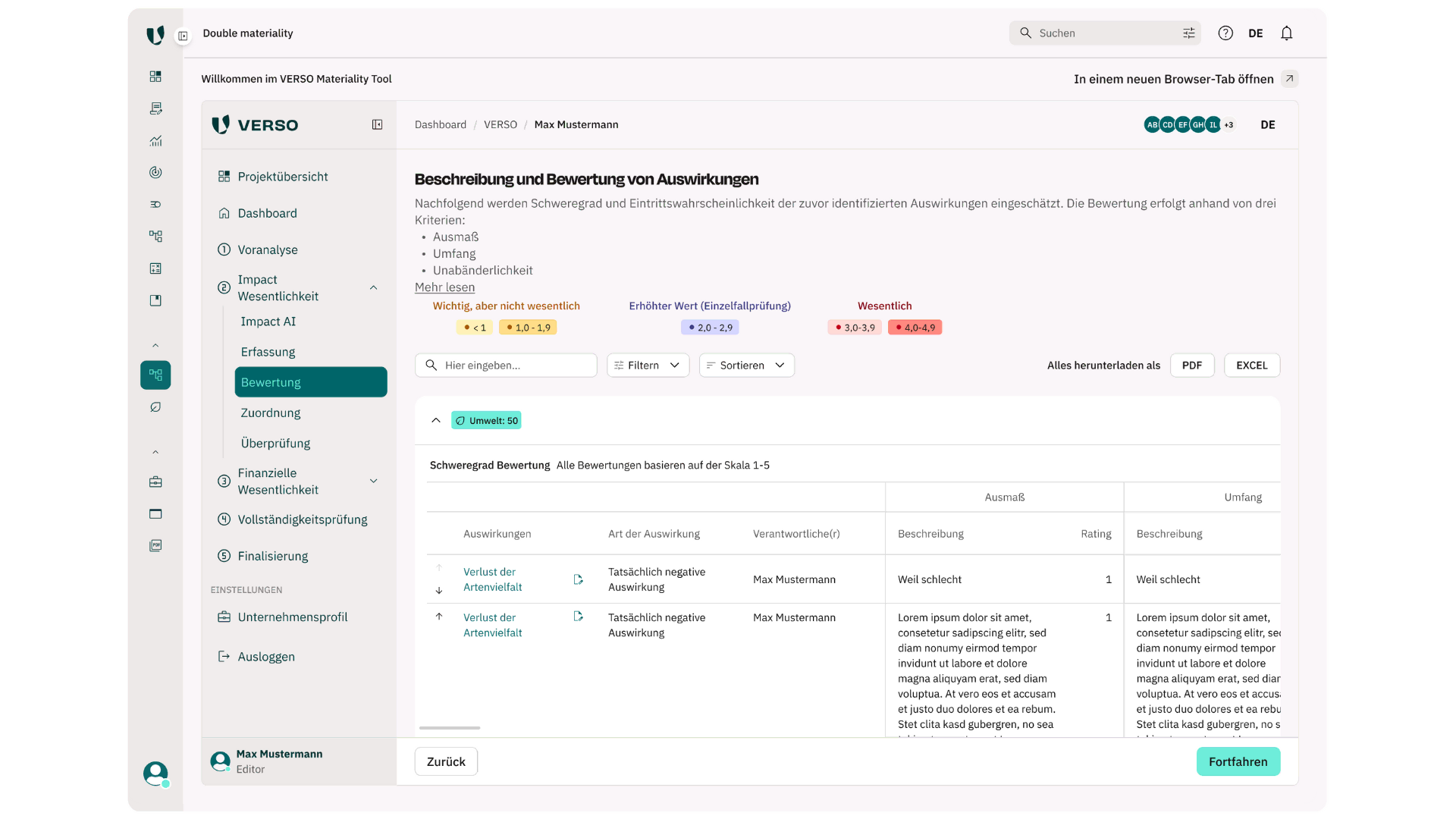
Mastering CSRD challenges: The double materiality analysis in seven steps
Which topics are relevant for the CSRD report?
The answer is provided by the double materiality analysis.In this article, you will learn how to efficiently master the analysis step by step with the support of our AI-based software solution.
In 7 steps through the double materiality analysis
1. Create an understanding of dual materiality
In the dual materiality analysis, you determine how sustainability aspects affect your company and how its activities impact the environment and society. We have already discussed the concept in this blog article. The double materiality analysis forms the start and basis for your sustainability reports in the coming years. A high-quality process and a well-founded result are therefore a must. In addition, auditors will audit the materiality analysis process and the finished CSRD report in the future. It is therefore worth going through the analysis in a tool that is recognized by auditors. VERSO’s AI-supported software solution for dual materiality guides you through the process step by step; the auditor can check directly in the tool. First, it is important for you and your sustainability team to take a closer look at the concept of double materiality. Here are some questions that are helpful in this first phase:
- Are we familiar with the concept of dual materiality? Does everyone in the team understand which perspectives (financial and impact materiality; impacts, risks and opportunities) need to be considered?
- What are the general conditions of our company, which topics could be relevant from the outset due to the environment, industry and products?
- Which upstream and downstream economic activities, from raw material extraction to consumption and disposal, are part of the value chain?
- Do we all understand what the dual materiality analysis process should look like, what our goal is, how we will proceed?
- Who are important stakeholders (e.g. those affected by impacts; groups with an interest in information) with whom we work and to whom we turn?
- Have we brought the management team on board and kept them sufficiently informed? Can we count on their commitment?
2. Create a roadmap for the dual materiality analysis
Once everyone is familiar with the topic and has gained an overview, the next step is to plan the analysis. Fundamental decisions should be made in three areas: Responsibilities: Clarify who in your team is responsible for what. You can define these responsibilities in the VERSO software. This allows you to assign different levels of authorization and keep track of who is working on which topics at all times. Time and resource plan: Analyzing dual materiality takes time. Create a schedule and consider what human and financial resources you need. Plan in such a way that you can talk to all affected stakeholders, involve management in the process and also coordinate the results well at the end. Think about all of this in the context of the sustainability report: have you considered the double materiality analysis when preparing the report or do you need to adjust the project plan? Sources and stakeholders: Consider which methods and with which stakeholders and colleagues you want to carry out the materiality analysis. The ESRS and other frameworks as well as industry standards and findings from the corporate environment provide you with starting points for possible relevant topics.
At VERSO, we have already supported many customers throughout the entire process – from the double materiality analysis to reporting. This includes, for example, the Deutsche Automobil Treuhand GmbH (DAT)which also uses the AI-supported VERSO software.
3. Identifying impacts, risks and opportunities (IROs)
A sustainability aspect of the ESRS is material and reportable if the associated impacts, risks or opportunities (IROs) are considered material. Example: If the pollution of wastewater by substances used is a material impact, this must be reported on the data points in the associated standard E2 “Environmental pollution”.
But how do you get to the IROs?
The IROs can arise from a wide variety of sources, such as industry or company specifics and discussions with various stakeholder groups. Sparring with the VERSO consultants is helpful here. In addition, internal data from whistleblower systems, occupational health and safety information or discrimination cases can provide you with information on relevant ESG issues in your company. VERSO makes it easier for you to determine the IROs: Based on your information on company activities, NACE codes, locations, industries, etc., our AI module suggests possible material topics. So you don’t start with a blank sheet of paper. You can start directly with individual effects and assign them to the respective topics. Anyone with a little knowledge of the subject will have noticed that our AI-supported materiality analysis module takes a bottom-up approach to IRO identification. Here, you first identify and evaluate the IROs so that the material topics of the ESRS emerge at the end. You could also do it the other way around – but in our experience, important topics often fall through the cracks.
The bottom-up approach in detail:
- Identify all actual and potential impacts that your company or your economic activities have or could have on stakeholders along the entire value chain(impact materiality or inside-out perspective).
- Define which financial opportunities and risks could arise for your company from sustainability issues(financial materiality or outside-in perspective). Here you can build on the results of the impact assessment.
- Sharpen the IROs to make them as specific as possible. You have clearly listed your collected impacts in the VERSO module. For a CSRD-compliant ESRS report, you must also specify the information and interests of your stakeholders. You must roughly describe which of your material IROs the stakeholders influence or experience impacts on. VERSO’s materiality module saves you time here too: you can enter the affected stakeholders when specifying the material topics and also describe these groups and their impacts in more detail.
4. Coordinating and sharpening of the IROs with the management
Now it is time to coordinate the preliminary results with your company’s management. The management level has a different view of the company and also knows other perspectives, such as those of investors. And finally, the dual materiality analysis should be supported by the entire company and form the basis for strategy development – management must be on board for this. It is best to present the results to management directly in our software. The data is clearly presented in the module, but can of course also be exported in the desired format and incorporated into presentations.
5. Definition of the main topics
In order to classify the IROs as material in accordance with the CSRD, they must be assessed according to the ESRS criteria. Among other things, you evaluate the IROs according to
- Extent,
- Scope,
- Immutability and
- Probability of occurrence.
Attention:
Depending on the type or category of IROs (e.g. actual or potential impact), different assessment criteria must be used. These categories are already stored in the VERSO software. You can select these for your IROs and assess the scope, extent and probability of occurrence with just a few clicks. Suitable threshold values are also already stored in the software solution. They help you to determine the IROs that are actually material for your sustainability report. The software automatically calculates the severity of the respective IRO. At the end, you can see at a glance which IROs are classified as material.
You can easily assign the identified IROs to the ESRS-compliant subtopics in the module. This results in the relevant topics for your report. IROs that do not fit any of the predefined topics can of course still be included and assigned to your own topics in the software. There is also a completeness check in the VERSO module to check whether you have evaluated and assigned all topics. You will see those ESRS topics and subtopics for which you have not entered any IROs. If such a topic seems important to you, you can refine it in the IROs. This way, no IRO will slip through. Topics for which you have not identified any material IROs are not included in the reporting obligation. At the end, you have all topics that have been assessed as material from either a financial or an impact perspective. You can present the results graphically in a materiality matrix or in a classic table. According to the CSRD, a graphical representation of the materiality analysis is not mandatory. And that’s it for the analysis itself: with our software, you can save your information in the final step and lock it for editing. The auditor can then check your analysis directly in the module. This last step is immensely important so that you can guarantee that the materiality analysis process has been carried out in accordance with the CSRD and checked by an auditor. With our software, you can also be sure that your double materiality analysis is ESRS-compliant and audit-proof in accordance with the requirements of the Institute of Public Auditors in Germany (Institut der Wirtschaftsprüfer – IDW). Once the materiality analysis has been completed, the material topics, standards and data points are transferred to the VERSO ESG Hub reporting module so that you can continue directly with your reporting.
6. Definition of measures
The double materiality analysis does not stand for itself: The material IROs serve as the basis for your sustainability report. This shows the status quo and, over the years, the development of your company in the area of sustainability. In addition, the materiality analysis is the basis for your sustainability strategy, in which you define targets and measures.Incidentally, the ESRS already provides you with valuable input for the definition of targets and measures. And you can find out how to approach the CSRD report in the CSRD practical guide.
7. Stick with it, adapt, repeat
A final tip from us: don’t see the double materiality analysis as a one-off project, but as an analysis tool that will accompany you in your sustainability work.
If there are significant changes in the company, you will have to repeat the double materiality analysis. You usually revise individual parts and adapt the analysis annually. This keeps the key IROs up to date and makes your company’s developments measurable.
Get to know the AI-supported materiality analysis directly
The dual materiality analysis is the basis of your CSRD report. We make this process easier and faster for you: with our AI-supported software solution for the dual materiality analysis, you can be sure that your analysis is CSRD-compliant. Try it out for yourself and book a demo where we will show you all the functions.
* This information is summarized editorial content and should not be construed as legal advice. VERSO accepts no liability.
This might also interest you:
Subscribe to our newsletter!
Sign up and receive regular news about:
- Current ESG topics and legislative changes
- Individual advice from the VERSO experts
- News about VERSO
- Trusted by 250+ customers




